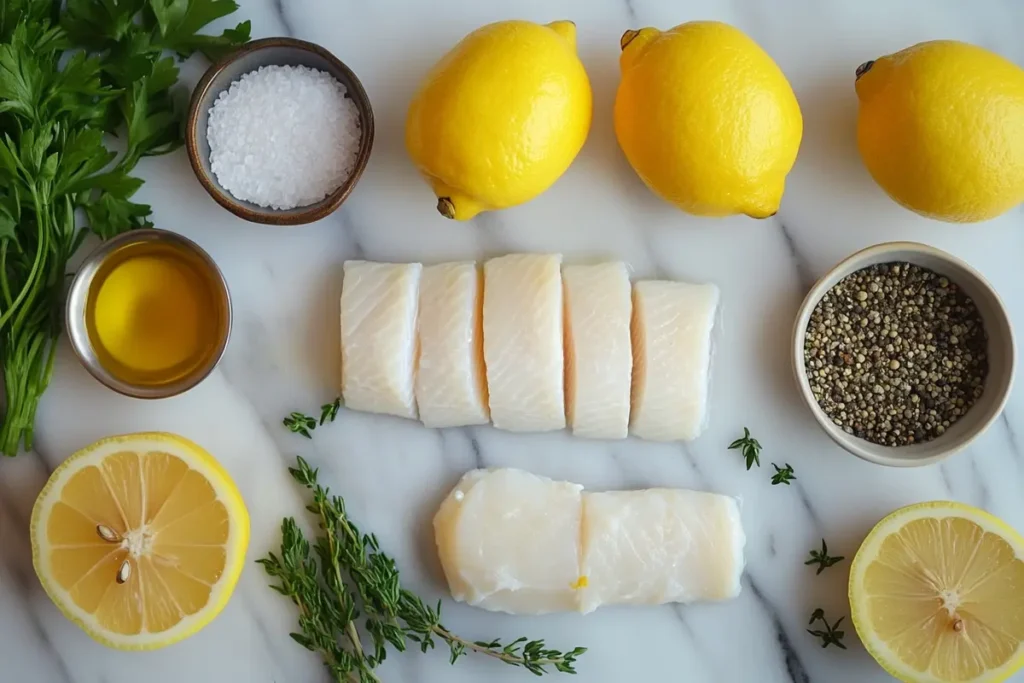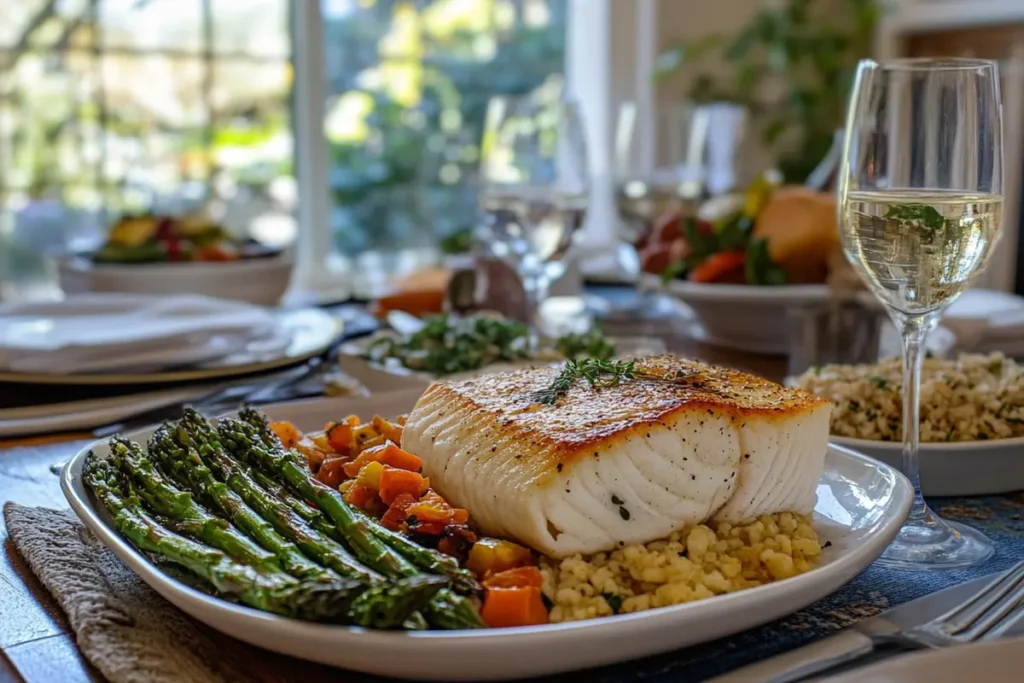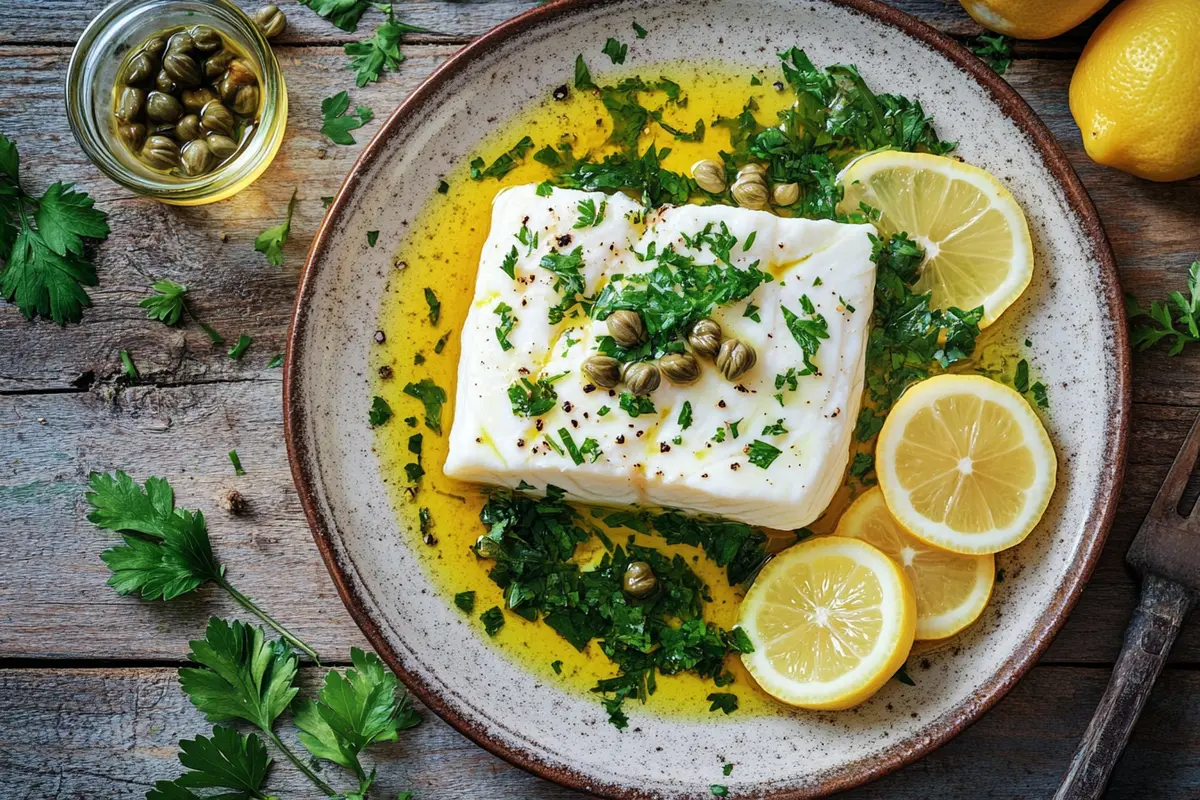The Ultimate Guide to Mediterranean Poached Halibut
Poached halibut has long been celebrated for its delicate texture and rich flavors. However, when paired with the vibrant ingredients of the Mediterranean, it truly becomes a culinary masterpiece. In this comprehensive guide, we will not only explore the process of selecting the freshest halibut but also guide you through creating an aromatic poaching broth infused with Mediterranean herbs and spices. Furthermore, you’ll learn step-by-step techniques to perfect this dish, while also discovering creative variations to make it your own. Additionally, we’ll provide tips on serving this dish with the ideal sides and wine pairings. So, let’s dive in and unlock the secrets of Mediterranean poached halibut!
Introduction to Mediterranean Poached Halibut
What is Mediterranean Poached Halibut?
Mediterranean poached halibut is a dish that beautifully embodies both simplicity and sophistication. Specifically, it involves gently cooking halibut in a seasoned liquid, allowing the fish to soak up all the vibrant flavors of ingredients such as garlic, lemon, capers, and olive oil. Moreover, this dish not only highlights the natural taste of halibut but also celebrates the essence of the Mediterranean diet. Renowned for its health benefits, the Mediterranean diet focuses on fresh, wholesome ingredients that make every meal both nourishing and flavorful. Therefore, Mediterranean poached halibut is a perfect choice for those seeking a healthy yet indulgent culinary experience.
Why Choose Halibut for Poaching?
Halibut is a firm, white fish with a mild, slightly sweet flavor that makes it ideal for poaching. Its texture holds up well during the cooking process, ensuring that it stays moist and flaky. Beyond its culinary appeal, halibut is packed with omega-3 fatty acids, high-quality protein, and essential nutrients, making it a heart-healthy option for seafood lovers.
Key Mediterranean Ingredients for Flavor
The beauty of Mediterranean cuisine lies in its reliance on simple yet flavorful ingredients. In this recipe, the magic truly happens with a carefully balanced blend of the following:
- Garlic: It not only adds depth and warmth but also enhances the overall savoriness of the dish.
- Lemon: Furthermore, it offers a zesty brightness that beautifully cuts through the richness of the fish.
- Capers: These bring a tangy, briny kick, which adds complexity and complements the halibut’s delicate flavor.
- Herbs like oregano, dill, and parsley: In addition, these infuse the dish with freshness and a hint of earthiness that ties all the flavors together.
- Extra Virgin Olive Oil: As a signature ingredient in Mediterranean cooking, it not only enhances flavor but also adds a luxurious, silky touch to the dish.
By skillfully combining these elements, Mediterranean poached halibut becomes a dish that showcases the essence of Mediterranean cooking—fresh, vibrant, and irresistibly delicious.ibut becomes an irresistible dish that’s as nutritious as it is delicious.
Ingredients for Mediterranean Poached Halibut
Essential Ingredients for Authentic Flavor
To create the perfect Mediterranean poached halibut, it’s essential to start with a well-rounded selection of ingredients that highlight the vibrant flavors of the Mediterranean. Key ingredients include:
- Fresh Halibut: Opt for firm, white fillets to ensure the dish’s delicate texture.
- Lemon Juice and Zest: These add brightness and balance to the richness of the dish.
- Garlic and Shallots: For depth and a subtle kick.
- Capers: A briny element that complements the fish.
- Olive Oil: The cornerstone of Mediterranean cooking, lending a luxurious mouthfeel.
Mediterranean Herbs and Spices Overview
Herbs and spices are the backbone of this dish. Use a mix of dried oregano, fresh parsley, and thyme to infuse the broth with earthy flavors. A pinch of smoked paprika can add a gentle heat and a touch of color.

Alternative Ingredients for Dietary Preferences
Catering to different tastes or dietary restrictions? No problem! Replace capers with sun-dried tomatoes for a sweeter twist, or swap white wine for vegetable broth to make the dish non-alcoholic. For extra flavor, try adding a splash of balsamic vinegar or pomegranate molasses.
For complementary side dishes, you can explore options like air-fryer roasted potatoes for a light, crispy accompaniment. Check out this recipe for inspiration.
Part 3: Step-by-Step Guide to Preparing Mediterranean Poached Halibut (500 words)
How to Select Fresh Halibut
The quality of your fish makes all the difference. Look for halibut fillets that are firm, with a translucent white sheen and no fishy smell. Avoid fillets with discoloration or dryness, as these can indicate poor quality or age.
Preparing the Halibut for Poaching
Before cooking, pat the fillets dry with a paper towel. This step ensures they absorb the poaching liquid’s flavors evenly. Lightly season both sides with salt and pepper for a simple yet effective base layer of seasoning.
Creating the Perfect Poaching Broth
The broth is where the magic happens! Combine water, white wine, lemon juice, and olive oil in a shallow pan. Add aromatics like garlic, shallots, and herbs to create an aromatic base. Bring the mixture to a gentle simmer—you want the liquid warm enough to cook the fish, but not boiling, to prevent toughness.
Cooking Techniques for Even Poaching
Gently slide the halibut fillets into the simmering broth. Cover the pan with a lid and let the fish poach for 6–8 minutes, depending on thickness. The fillets are done when they turn opaque and flake easily with a fork.
For a guide to creating perfectly tender protein dishes, explore the fundamentals of slow cooking, like this festive turkey cranberry pizza recipe here.
Benefits of Poaching Halibut Mediterranean Style
Health Benefits of Halibut
Halibut is a nutritional powerhouse. Rich in omega-3 fatty acids, it supports heart health, brain function, and joint mobility. It’s also packed with high-quality protein and essential vitamins like B6 and B12, making it a valuable addition to a balanced diet. For those following a Mediterranean diet, poaching halibut aligns perfectly with its emphasis on fresh, wholesome ingredients.
Why Poaching is a Healthier Cooking Method
Poaching is one of the healthiest ways to cook fish. Unlike frying or sautéing, it requires no heavy oils or fats, making it a low-calorie option. The gentle cooking process preserves the fish’s natural nutrients while infusing it with the vibrant flavors of the broth. This technique is perfect for those looking to enjoy Mediterranean poached halibut as a light yet flavorful meal.
Mediterranean Diet Advantages
The Mediterranean diet is often hailed as one of the healthiest eating patterns in the world. It emphasizes fresh produce, lean proteins, and healthy fats like olive oil. When you poach halibut in a Mediterranean-inspired broth, you’re creating a dish that’s not only delicious but also aligned with principles that promote long-term well-being.
For more ways to incorporate Mediterranean flavors into your cooking, check out our article on delicious spinach dip recipes.
Creative Variations of Mediterranean Poached Halibut
Adding Citrus Zest for a Flavor Twist
For a brighter, zippier version of Mediterranean poached halibut, try adding citrus zest. Lemon, orange, or lime zest can elevate the dish by adding a hint of sweetness and tang. This tweak pairs well with side dishes like a crisp, fresh salad or steamed vegetables.
Incorporating Capers and Olives
Capers and olives are quintessential Mediterranean ingredients that add a bold, briny depth to the dish. Sprinkle these over the poached halibut just before serving for added texture and flavor. Kalamata olives work particularly well, complementing the tender fish with their rich, fruity notes.
Exploring Wine-Based Poaching Broths
White wine enhances the broth’s complexity, lending a subtle sweetness and acidity that balances the dish. When using wine, choose a dry variety like Sauvignon Blanc or Pinot Grigio to complement the other Mediterranean flavors. For a non-alcoholic alternative, vegetable stock with a splash of apple cider vinegar works wonderfully.
Using Olive Oil for Slow Poaching
Slow poaching the halibut in olive oil instead of water or broth creates an exceptionally tender texture. This method, also known as confit, involves gently heating olive oil with aromatics like garlic, rosemary, and thyme before immersing the fish. The result is a luxurious, melt-in-your-mouth experience.
For additional ideas, check out our recipe collection for dishes that highlight Mediterranean cooking principles, like our guide on festive turkey cranberry pizza.
Serving Mediterranean Poached Halibut
What to Serve with Poached Halibut?
The beauty of Mediterranean poached halibut lies in its versatility. Pair it with a simple side dish to let the flavors shine or complement it with something bold for a well-rounded meal. Popular choices include:
- Garlic-infused couscous: Light and fluffy, it absorbs the aromatic broth beautifully.
- Steamed asparagus or green beans: These fresh greens add a crisp, vibrant contrast.
- Mediterranean salad: A mix of tomatoes, cucumbers, and feta drizzled with olive oil ties the meal together.

Mediterranean Side Dishes to Complement Halibut
For a more elaborate spread, consider classic Mediterranean side dishes. Roasted potatoes seasoned with rosemary or a rich ratatouille featuring zucchini, eggplant, and bell peppers can elevate the meal. You might also try a warm lentil salad with fresh herbs and lemon for added texture and flavor.
Wine Pairings for Mediterranean Halibut
A glass of wine can perfectly complete this dish. Dry white wines like Sauvignon Blanc or Chardonnay bring out the fish’s delicate flavors without overpowering them. If you prefer reds, a light-bodied Pinot Noir is a surprisingly good match. Don’t drink wine? Sparkling water with a squeeze of lemon is a refreshing non-alcoholic alternative.
FAQs About Mediterranean Poached Halibut
What is the Best Cooking Method for Halibut?
Poaching is one of the best methods for cooking halibut. It keeps the fish moist and tender while allowing it to soak up the flavors of the aromatic broth. Unlike grilling or frying, poaching is gentle, ensuring the fish doesn’t overcook.
What to Serve with Poached Halibut?
Mediterranean poached halibut pairs well with light sides like quinoa, couscous, or roasted vegetables. These options enhance the dish’s flavors without competing with its delicate taste. For added flair, drizzle the fish with a lemony vinaigrette before serving.
What is the Difference Between Halibut Fillets and Halibut Steaks?
Halibut fillets are cut from the sides of the fish, offering a smooth, boneless piece that’s easy to poach. Halibut steaks, on the other hand, are cross-section cuts that include the bone. While steaks offer richer flavor due to the bone, fillets are more convenient for this recipe.
How Long Does It Take to Sous Vide Halibut?
Sous vide cooking halibut takes about 30–45 minutes at a steady temperature of 130°F (54°C). This method guarantees precise results, delivering a texture similar to poaching but with enhanced flavor infusion.
Tips and Tricks for Perfect Mediterranean Poached Halibut
Avoiding Common Mistakes When Poaching
When preparing Mediterranean poached halibut, even small missteps can impact the final result. To ensure success:
- Keep the liquid at a gentle simmer: Avoid boiling the broth, as this can toughen the fish.
- Don’t overcrowd the pan: Leave enough space for each fillet to cook evenly.
- Check doneness carefully: Halibut is ready when it flakes easily but remains moist. Overcooking dries it out.
Enhancing Flavor with Fresh Herbs and Citrus
For an aromatic twist, always use fresh herbs like parsley, dill, or thyme to garnish the halibut. Adding a final squeeze of lemon juice before serving brightens the flavors. You could also experiment with lime or orange zest for a unique citrus note.
Timing Tips for Perfectly Cooked Halibut
Timing is crucial when poaching. A good rule of thumb is to cook each inch of thickness for about 7–10 minutes. Using a food thermometer ensures precision; the internal temperature should reach 130–135°F for a perfectly tender result.
With these tips in mind, creating a flawless dish of Mediterranean poached halibut is simpler than you think.
Conclusion and Final Thoughts
Summarizing the Mediterranean Poached Halibut Experience
In this guide, we’ve explored everything you need to know about creating a memorable dish of Mediterranean poached halibut. From selecting the freshest fish to crafting a flavorful poaching broth, each step is designed to bring out the best in this delicate seafood. Whether you stick to the classic recipe or experiment with variations, this dish offers a versatile and healthful addition to any meal.
Encouragement to Experiment with Mediterranean Recipes
Cooking is as much about creativity as it is about technique. Therefore, don’t hesitate to make Mediterranean poached halibut your own by playing with herbs, spices, or side dishes. The beauty of Mediterranean cuisine lies not only in its adaptability but also in its celebration of fresh, vibrant flavors.
If you’re ready to try more Mediterranean recipes, consider exploring exciting ideas like hearty salads, roasted vegetable medleys, or other seafood dishes. In addition, you could experiment with grain-based dishes like couscous or tabbouleh to add variety to your repertoire. Furthermore, incorporating ingredients like olives, capers, or sun-dried tomatoes can elevate the taste of your meals.
The journey to mastering Mediterranean cooking is as delightful as the meals themselves. Indeed, every dish offers an opportunity to embrace the region’s rich culinary traditions while letting your imagination run wild. Thus, enjoy the process, and don’t be afraid to experiment!

